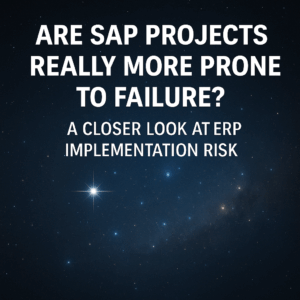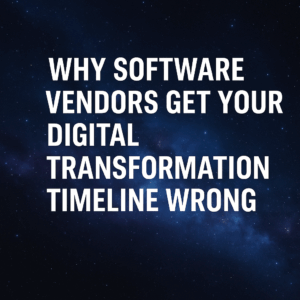So you’re thinking about starting a digital transformation? That’s great! There are many things to consider when making this kind of investment. The early steps you take in a digital transformation will largely determine whether your project is successful or not. We’ve compiled some helpful tips for getting started with our article today. In this article I will be your Digital Transformation Leader.

Table of Contents
ToggleWhat not to do when starting a digital transformation
Now before we jump into the tasks we recommend to start, let’s talk about the things we would not do.
Contact Software Vendors
The first thing we don’t suggest is that you immediately begin to reach out to software vendors. It may seem like an obvious choice to begin by scouring the internet, contacting vendors, and signing up for software demos but this can actually be counterproductive as an initial step in the process. We will get more into what the first steps are shortly.
Contact System Integrators
Next, similar to the previous point, we also would not recommend you immediately contact system integrators. More than likely they will be biased. System Integrators have their own agenda, many have partnerships with software vendors, and it’s more than likely they won’t offer objective insights on which product is best for your company and your company strategy.
Contact Biased Parties
The final thing we would suggest not to do is contact biased parties about what your transformation strategy should be. We mentioned a couple of examples or biased parties, including software vendors and system integrators but another party is biased ERP consultants. Most ERP consultants do not offer an agnostic approach to selection and strategy. Most are focused solely on one technology which creates bias in the decision making process. Focus more on objective views of getting started.
Where To Start In Your Digital Transformation Journey
Start With Strategy
The first thing we suggest is you understand your strategy as an organization. What kind of business are you trying to become, what are your growth priorities, what kind of culture are you trying to create, what are your operational pain points and opportunities? Make sure you fully understand what kind of organization you are today and what kind of organization you strive to be in the future.
Make sure you fully understand your overarching strategy before you even discuss technologies. Once you fully have a framework established for your strategy then yes, you can begin the software selection and research process.
One of the most common reasons transformations fail is because of strategic misalignment. Similar to flying a plane, if you have competing headwinds, it can slow you down. We want you flying with only tailwinds and thats what having proper alignment is like prior to launch. This will save time and money and loads of stress along he way.
Analyze Operations
Once you have dialed in your strategic imperatives as an organization, we suggest you then start to dive into understanding your operations. What is working today? What are your pain points? How can you provide a better customer experience? How can you optimize your employee experience internally? These are all things that need to be considered early in the process. It is imperative to understand what is working today in your organization and fixing those pain points while planning for the future.
Change Ready Assessment
Continuing on the theme of not jumping straight in to a technology assessment, the next thing you should consider is your organizations readiness for change. To clarify, what we don’t mean is your organizations readiness to go live with new tech. We are looking to identify resistance to cultural change within your organization. Tech readiness comes later in the process. To start we need to analyze any internal priorities and politics that might get in the way of change. Better to fully understand any underlying resistance early in the stages than having to deal with issues later in the process when it’s not as easy to pivot.

Assess Technology Options
Once the foundational aspects of strategy, operations and change readiness have been fully assessed, now we can begin the process of assessing the technology options. Initially it’s a good place to start by deciding which technologies best align with the key indicators we mentioned earlier.
There are a variety of options in the marketplace and aligning them with your overall strategic goals is imperative.
When evaluating alternatives it is important to understand that you will not find any one option that meets all of your criteria 100%. Each option has their own strengths and weaknesses as well as pros and cons. It’s crucial that you are able to exercise objectivity in the process. Ultimately as you progress through the selection process, your team will start to gravitate to a couple options. Make sure that option aligns with your goals, aligns with your company strengths and weaknesses and you have fully assessed the time and cost risks.
Establish Project Governance
This next step may actually need to be done in parallel with some of the previous activities we have discussed. That is to establish project governance.
This is the part of the process where you will be highlighting and prioritizing the roles and responsibilities of everyone from your executive team all the way down to your people on the front lines. Each person in the organizational puzzle will be critical to making a transformation successful.
Additionally its imperative you identify and gaps in your team and project org-chart. Some roles may end up being filled by your software vendor or system integrator or additional outside third parties but its better to identify these holes and prepare ahead of time.
Project governance should also provide clarity on how decisions are made, who makes those decisions and how those decisions are escalated. This will provide more ownership of the project internally, this is an important part of a successful digital transformation.

Build the Case For Change
The last thing we recommend is looking at a quantitative case for change in terms of the pros and cons and the overall ROI for transformation.
Also look at why your organization needs to go through this transformation in the first place. What is it you are trying to accomplish as an organization. Much of this case for change ties back to the first bullet we discussed here which is the strategic alignment and what that means to the organization. Once this is identified we can start deploying that messaging throughout the organization so that the average stakeholder and frontline employee fully understands and is aware of how this transformation is going to support the overall goals and objectives.
There are many things to consider when thinking about making an investment in a digital transformation. The steps you take early on can have a major impact on how successful of a transformation your organization has. Hopefully this outline is of value in preparing your organization. If you have any questions or would like me to be a sounding board for an upcoming transformation, please don’t hesitate to reach out to me here ryan.glisan@thirdstage-consulting.com.
I’d also highly recommend downloading the 2023 Digital Transformation Report which is packed full of industry insights and best practices.





